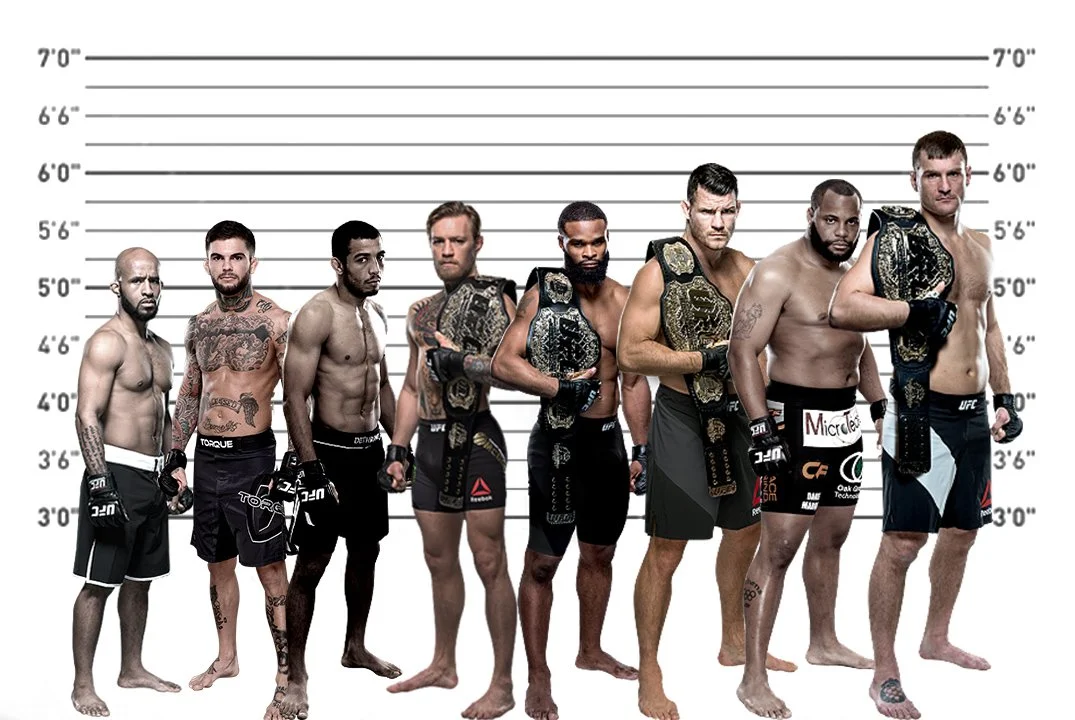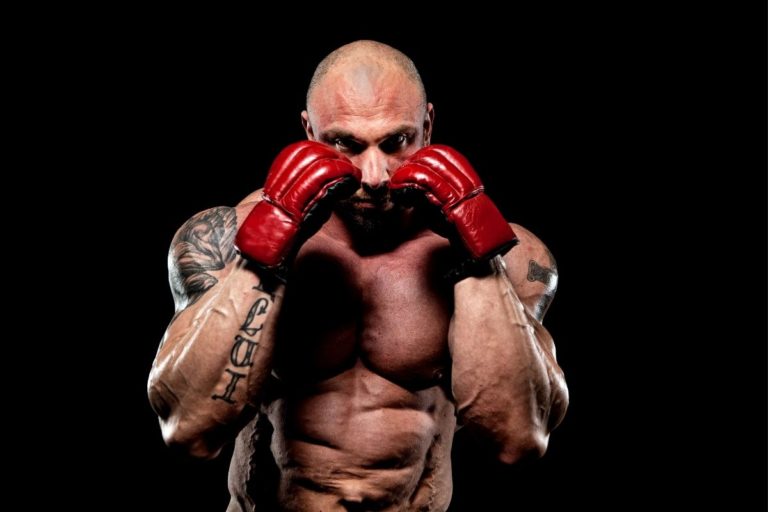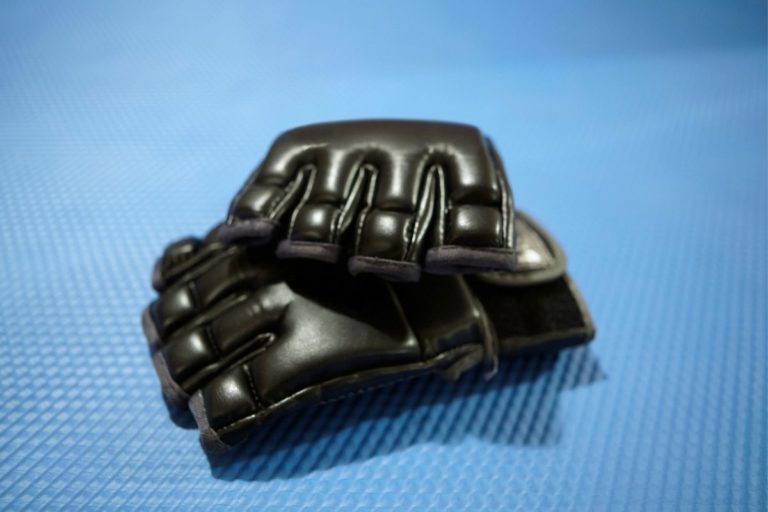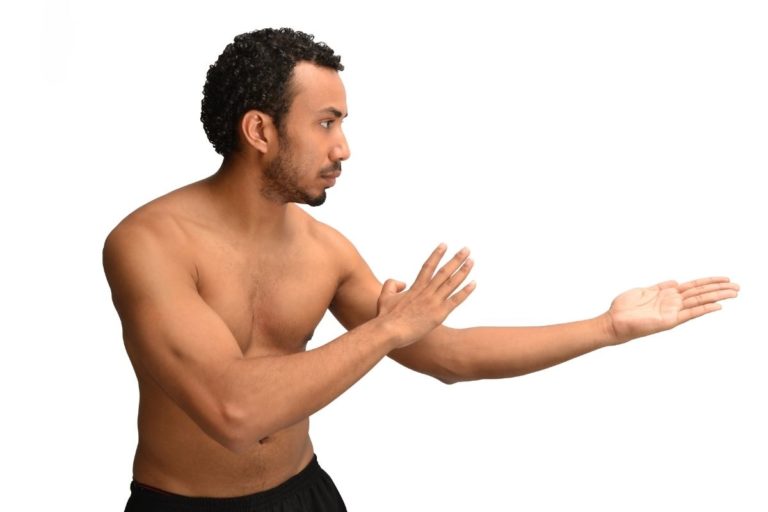How Tall Are MMA Fighters?
MMA is a game of inches where size plays a big factor. A few inches of reach or height advantage is often a decisive factor and directly impacts the outcome of the fight. That being said, how tall are UFC fighters from each weight class? Who is the tallest UFC fighter of all time?
The height of UFC fighters is often in direct relation to their weight. This means that fighters in the lower weight classes are shorter and they get taller with each heavier weight class. Standing 7’0″, or 2,13m high, the heavyweight Stefan Struve remains the tallest UFC fighter in history. On the other side, flyweight Hector Sandoval was the shortest UFC fighter standing 5’2″ (157cm).
Keep reading this article to learn more about the average height of UFC fighters per division. You will also learn all about the advantages as well as disadvantages of being tall in MMA.
Women’s strawweight (115 lb; 52.5 kg)
The average height for female fighters who compete in the strawweight division is 5’4″ (168cm). The tallest top 10 fighter in the division is Marina Rodriguez who stands 5’6″ (167.5 cm) and the former champ, Rose Namajunas who is 5’5″ (165 cm). The shortest ones are Carla Esparza and Tecia Torres who are both listed as 5’1″ (155cm).
Women’s flyweight division (125 lbs; 56.7 kg)
The average height in the women’s flyweight division is 5’5″ (165cm). The tallest ranked fighter is Katlyn Chookagian who is 5’9″ (175cm) tall, while the shortest fighter is Jessica Andrade 5’2″ (157cm).
Women’s bantamweight division (135 lbs; 61.2 kg)
The average height for female UFC fighters who compete in the bantamweight division is 5’6″ (167.5 cm). The tallest ranked fighter is the former title challenger Germaine de Randamie who stands 5’9″ (175cm) with the Karol Rosa being the shortest 5’5″ (171cm).
Men’s flyweight division (125 lbs; 56.7 kg)
The average height of the UFC flyweight fighter is 5’5″ (165cm). The tallest athlete inside the top 10 are Brandon Royval who is 5’9″ (175cm) and Sumudaerji who is 5’8″ (173cm) while the shortest is Kai Kara-France 5’4″ (163cm).
Men’s bantamweight division (135 lbs; 61.2 kg)
UFC fighters who compete in the bantamweight division are 5’7″ tall on average. The tallest ranked fighters are Sean O’Malley and Cory Sandhagen who are both 5’11” tall (180cm). TJ Dillashaw and Merab Dvalishvili are among the shortest standing at just 5’6″ (167.5cm).
Featherweight division (145 lbs; 65.8 kg)
The average height of UFC featherweight fighters is 5’9″. The tallest fighter in the division is Giga Chikadze who is 6’0″ (183cm) and has an amazing reach of 74.0″ (188cm), followed by Yair Rodriguez, Max Holloway, and Calvin Kattar who all stand 5’11” (180cm) tall. The shortest fighter is Dan Ige who is 5’7″ (170cm).
Lightweight division (155 lbs; 70.3 kg)
The average height of UFC lightweight fighters is 5’10” (178cm). The tallest lightweight is Dan Hooker who is 6’0″ (183cm) tall, and some of the other tall ones are Tony Ferguson and Justin Gaethje who are both 5’11” (180cm) tall. Among the shortest ones are Michael Chandler and Rafael Dos Anjos who are 5’8″ (173cm), and Gregor Gillespie 5’7″ (170cm).
Welterweight division (170 lbs; 77.1 kg)
UFC welterweight fighters are 5’11” (180 cm) tall on average. The tallest ranked fighters in the division are Neil Magny who is 6’3″ (191cm), and Khamzat Chimaev and Leon Edwards who are 6’2″ (188cm) tall. Standing 5’10” (178cm), the shortest ranked fighter is Sean Brady.
Middleweight division (185 lbs; 83.9 kg)
UFC fighters who compete in the middleweight division are 6’1″ (185cm) tall on average. The tallest ranked fighter is Israel Adesanya who is 6’4″ (193cm) tall and has a really high reach of 80.0″ (203cm). The shortest fighter is, by far, Kelvin Gastelum who is 5’9″ (175 cm).
Light Heavyweight division (205 lbs; 93 kg)
The average height of UFC light heavyweight fighters is 6’2″ (188cm). The tallest ranked fighter in a division is Johnny Walker who is 6’6″ (198cm), and some other tall ones are Aleksandar Rakic and Dominick Reyes who are 6’4″ (194cm).
Heavyweight division (265 lbs; 120.2 kg)
6’3″ (190.5) is the average height of UFC fighters who compete in the heavyweight division. The tallest UFC heavyweight is Alexander Volkov who stands 6’7″ (201cm) tall and Tom Aspinall who is 6’5″ (196cm). The shortest ranked UFC heavyweight fighter is Blagoy Ivanov who stands 5’11” (181cm).
Who is the tallest UFC fighter ever?
As of 2022, the tallest UFC fighter in history remains the Dutch kickboxer, Stefan Jaimy Struve who stands 7’0″ (213cm). Also known as the “Skyscraper”, Struve had a long MMA career and he fought under the UFC banner for 11 years. At one point on his UFC journey, he was very close to fighting for the heavyweight title.
In 2012, he put together a four-fight win streak which secured him a contender status. One of those 4 wins came against none other than the best UFC heavyweight ever, Stipe Miocic. Yet, his win streak and chances of receiving a title shot would come to an end with a brutal loss against Mark Hunt in 2013. This was a major setback and Struve was never the same after this fight.
As an elite kickboxer with such a big height and reach advantage, Struve was a tough matchup for anyone. Most of the time, he did a really good job of utilizing these advantages to keep his range and pick his opponents apart from the distance. But at the same time, he was prone to takedowns, which remained his biggest weakness. He had a really, really hard time dealing with elite wrestlers.
Biggest height difference in a UFC fight
One of the biggest height differences in a fight in MMA history came when Pat Barry, listed at 5’11” (180cm), fought against the giant Stefan Struve who is 7’0″ (213cm). Yes, there had been matches throughout MMA history with bigger height differences, but those were mostly freak shows. Struve vs Barry was a high-level UFC match.
Struve remains the tallest UFC fighter in history while Pat Barry falls into the group of the shortest ones. In the opening round at “UFC on Versus 6, Barry did a really good job of pressing forward, forcing Struve to circle around and fight off the back foot.
He was blasting the “skyscraper” with powerful leg kicks while Struve had a hard time finding the target. But in the second, Struve would switch to grappling and catch Barry into the nasty triangle choke to win the match.
Advantages of being tall in MMA?
Tall MMA fighters usually have a high reach because the height to reach ratio is close to 1:1. Having a high reach has many benefits because it allows you to keep your range and hit the opponent from a safe distance. A fighter who has a reach advantage and knows how to get the most out of every inch can land a strike without worrying much about being hit back.
A shorter opponent needs to close the distance first before landing a shot. This is easier said that done because each time they step forward they risk being hit with the counter. Since they control the space in front, a taller fighter has a time to move away, dodge/slip the strike, or counter with a straight shot down the middle.
When it comes to grappling, taller fighters have an edge when it comes to position control simply because they have a much wider base. It is also much harder for shorter fighters to escape when a tall fighter secures a dominant position, such as when they have both hooks locked in for instance.
Some of the masters of getting the most out of every inch advantage are fighters like Jon Jones and Israel Adesanya, who are among the tallest fighters in their weight classes. Both of these fighters prefer to fight at the safe distance, catch their opponents coming in, and with that, dictate the pace and tempo of the fight.
What is the disadvantage of being tall in MMA?
One of the biggest cons of being tall in MMA is the lack of speed and mobility. Shorter fighters are, in most cases, much faster during the exchanges, and are far more explosive. They are also, in most cases, more muscular, agile, and physically stronger. This makes them capable of generating more power both in striking and grappling than taller opponents.
Next, being tall and having long limbs has a negative impact on your ability to move and react quickly. This combined with their tall base makes them prone to takedowns and submissions. Shorter fighters who are faster and more explosive are capable of quickly closing the distance, diving for the single/double leg, and breaking the base of the taller fighter.
Also, tall fighters usually have a much bigger and longer torso which makes them a large target for vicious body kicks and punches at close range. No matter how good their defense is or how tight their guard might be, they just can’t protect themselves the same as shorter fighters can.
Why there is such a big height-to-weight ratio in MMA?
Looking at the height of UFC fighters in each division, you can’t escape but ask yourself, why they are so skinny? For example, Neil Magny is 6’3” (191cm) tall and he competes in a 170-pound weight class, and there are many other examples. Well, the answer is extreme “weight cutting”, the process of losing weight each modern fighter needs to go through.
All MMA fighters are actually much heavier when they are outside of the competition. For example, Neil Magny walks at around 190+ pounds and competes in a 170-pound weight class, while Conor McGregor is close to 190 pounds and competes in a 155 division.
In a week leading up to a fight, each UFC fighter loses up to 30 pounds, or around 10–15% of their body mass, to compete in a weight class below their natural one. They do this by decreasing the water intake, cutting carbs to 50 grams per day, and sweating a lot in the sauna. This why they look drained and exhausted standing on the scale during the weigh-ins. But once that’s over, they have around 24h to re-hydrate and gain the majority of the weight back.
So on paper, Neil Magny who is 191cm tall, weighs 170 pounds when he steps on the scale during the weigh-ins, which is a big height-to-weight ratio. But 24h later, he would enter the cage weighing much, much more, close to 200 pounds in some cases.
Does height equal reach in MMA?
No, height does not equal reach, not just in MMA, but in most other combat sports as well. Yes, the height-to-reach ratio is 1:1 for most average people. Or in other words, your wingspan equals your height. But in MMA, fighters’ reach is usually higher than how tall they are, around 3 inches or more on average. Some physically gifted athletes who have wide shoulders or long arms have a really long reach.
How do they measure reach in MMA? The process is quite simple, each fighter must stand up, lift and extend their arms to the side at shoulder level parallel to the ground. Next, the official would measure the distance between the tip of the middle finger on one hand, all the way to the tip of the middle finger on the other hand. But since the height to reach ratio differs a lot in physically gifted athletes, they use a different type of measurement method called “apex index”.
To calculate the apex index, they just need to subtract the fighters’ height from their reach.







